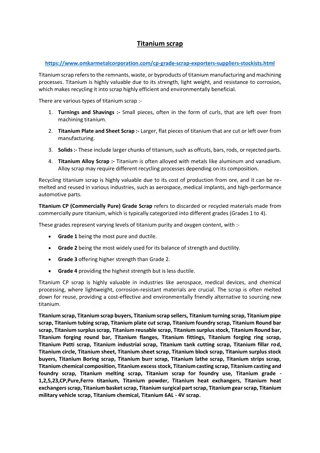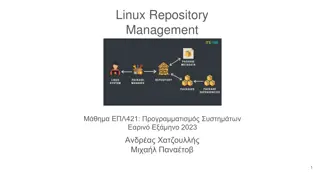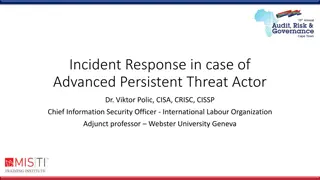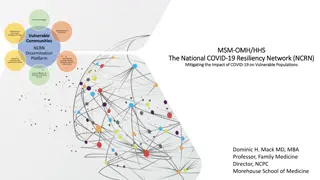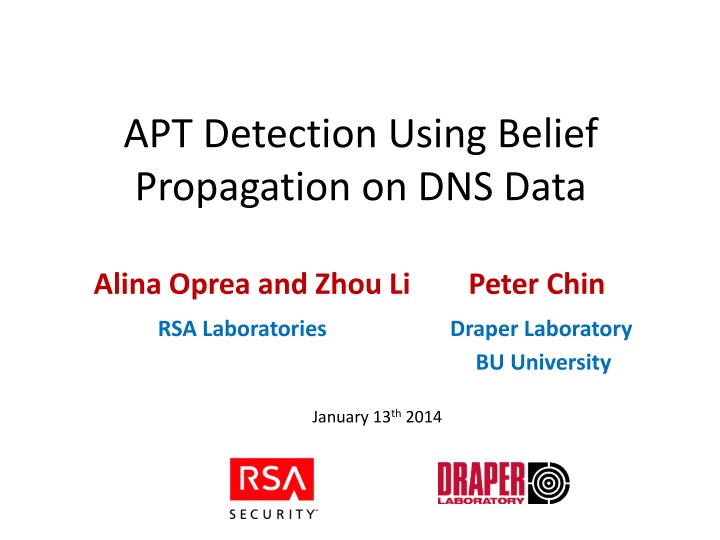
Analyzing APT Detection Strategies using Belief Propagation on DNS Data
Explore the application of Belief Propagation on DNS data for detecting Advanced Persistent Threats (APTs) in network security. Learn about identifying suspicious connections, situational awareness through domain analysis, and reducing and normalizing data for threat detection.
Download Presentation

Please find below an Image/Link to download the presentation.
The content on the website is provided AS IS for your information and personal use only. It may not be sold, licensed, or shared on other websites without obtaining consent from the author. If you encounter any issues during the download, it is possible that the publisher has removed the file from their server.
You are allowed to download the files provided on this website for personal or commercial use, subject to the condition that they are used lawfully. All files are the property of their respective owners.
The content on the website is provided AS IS for your information and personal use only. It may not be sold, licensed, or shared on other websites without obtaining consent from the author.
E N D
Presentation Transcript
APT Detection Using Belief Propagation on DNS Data Alina Oprea and Zhou Li Peter Chin RSA Laboratories Draper Laboratory BU University January 13th 2014
APT Kill-Chain Command-and-Control Download malware Social Engineering Lateral Movement Data Exfiltration 2
Suspicious external connections Command-and-Control Download malware Monitor external DNS queries Command-and-Control to detect connections to suspicious domains Lateral Movement Data Exfiltration 3
Overview Situational awareness Identify internal subnets, end hosts and servers Data reduction and normalization Filter internal queries and queries made by servers Profile typical host activity Domains contacted by each host during training month Detect new, suspicious activity Belief propagation on bipartite graph with host-to-domain edges Start with set of known compromised hosts when available At each iteration, detect malicious domains and augment set of compromised hosts Hosts Domains 4
Situational awareness No of unique domains (on 02-01): 735,562 No of unique source IPs (on 02-01): 83,472 Most popular domain: webb.bin (internal site) Domain hat.webb.bin gig.webb.bin baas.webb.bin cot.webb.bin weediest.webb.bin ego.webb.bin impregnates.webb.bin skateboards.webb.bin urey.webb.bin decamped.webb.bin No. hosts 22085 21560 17220 16572 14157 11867 11845 11561 11376 10880 5
Identify internal servers Parse MX records to identify internal mail servers Mail server 252.90.88.52 252.90.88.53 252.90.88.28 No. queries 30480 27020 8758 Identify internal DNS servers DNS Server 252.90.88.59 252.90.88.58 74.92.185.4 74.92.185.33 252.90.214.1 74.92.251.88 74.92.168.21 No. queries generated 263519 258687 257164 54025 8069 3492 1644 No. queries received 5259406 5149688 48554974 2550625 5264109 2851958 389541 6
Data reduction and normalization 02-01 Filter queries to internal resources 800000 700000 Filter queries made by servers 600000 Folding to third-level domain # Domains 500000 400000 300000 200000 100000 0 All Internal Servers Fold Stage Normalized representation daily: For each host and folded domain keep list of query timestamps For each domain store list of IP Domain names Folded domains r13---sn-p5qlsnel.c.youtube.com as-api-elb-1971836622.us-west-2.elb.amazonaws.com scontent-b-lga.xx.fbcdn.net addresses to which it resolves c.youtube.com elb.amazonaws.com xx.fbcdn.net 7
Profiling external destinations Profile domains visited by each host during training month New domains: domains never visited before by any host Unpopular domains: domains visited by a small number of hosts #Domains after folding #New AND Unpopular Domains 300000 250000 # Domains 200000 150000 100000 50000 0 03-04 Mon 03-05 Tue 03-06 Wed 03-07 Thu Day 03-08 Fri 03-09 Sat 03-10 Sun 8
Detect suspicious domains Consider new and unpopular domains Identify automated activity (not human generated) DNS query times from a host to a domain Time 8:00 8:30 9:30 9:59 10:05 10:35 11:05 11:35 7:30 Inter- pi qi Periodic histogram connection histogram ??log?? ?? + ??log?? ? Jeffrey divergence: ?=1 ?? 9 ??= (??+ ??)/2
Case 1 New and unpopular domains contacted by compromised host cot.ai65-x0kvt61ck0wh9.wad aa8n-1tan7-289-9ts90*.wad 03-04 ag3rramh8xygf2xs-8p.wad shrdhost.mungled.wad aqryo6cefn3.sharif.wad atrvqg-8v.fiberglas.wad aev4ewfd2.fifths.wad seasick.adx0w0.don viagra.adx0w0.don aqryo6cefn3.wad glazes.mrsifor.in tut.adx0w0.don grandfenagle.in cot.abtir.wad 10:24 10:56 11:07 11:21 15:04 16:24 7:26 Time 1. Beaconing at 19 minutes 2. Expand to domains contacted close in time 10
Case 2 New and unpopular domains with automated activities contacted by at least one compromised host 03-05 Hosts Domains 74.92.98.236 bniely.rd cot.abu2i.wad andean.asebfray.wad ajk3llkryfp0q-xuzz.wad ar8tzyhw.fatality.wad 74.92.150.196 l8h.us 74.92.169.145 105 domains 11
Case 2 New and unpopular domains contacted by at least two compromised hosts 03-05 Hosts Domains 74.92.98.236 bniely.rd Beaconing at 59 minutes 74.92.150.196 austerfold.rd pucker.a5sk3.rd 74.92.169.145 12
Case 2 But malicious domains could be contacted by only one host! 03-12 Hosts Domains 74.92.56.31 flashforward.narc.dw 74.119.145.200 groverly.action.don 74.146.246.44 74.92.12.12 No beaconing! 74.92.32.119 westeros.action.don 74.146.246.44 74.92.32.72 Label malicious all domains in same /24 subnet with known malicious domain 13
Case 3 - Belief Propagation 03-19 Iteration 1 Hosts Domains Beaconing at 10 minutes rainbow-.c3 74.92.144.170 191.146.166.145 /24 subnet fluttershy.c3 252.90.88.2 191.146.166.31 74.92.144.27 74.92.144.31 Identify one or several malicious domains (beaconing) Augment set of compromised hosts Expand set of domains (new and unpopular domains) 14
Case 3 - Belief Propagation 03-19 Iteration 2 Hosts Domains Beaconing at 10 minutes 74.92.144.170 rainbow-.c3 /24 subnet fluttershy.c3 252.90.88.2 Max score pinkiepie.c3 74.92.144.27 74.92.144.31 Identify one or several malicious domains (max score) Augment set of compromised hosts Expand set of domains (new and unpopular domains) 15
Case 3 - Belief Propagation 03-19 Iteration 3 Hosts Domains Beaconing at 10 minutes 74.92.144.170 rainbow-.c3 /24 subnet fluttershy.c3 252.90.88.2 pinkiepie.c3 74.92.144.27 applejack.c3 Max score 74.92.144.31 74.92.144.137 Identify one or several malicious domains (max score) Augment set of compromised hosts Expand set of domains (new and unpopular domains) 74.92.144.186 16
Computing domain score Score is function of: Timing correlation with known malicious domain Similar /16 subnet with malicious domain Overlap with set of malicious hosts Timing correlation across hosts Yes No Yes 2 Iteration 2 Domains Hosts 16:16 rainbow-.c3 191.146.166.145 74.92.144.170 16:16 252.90.88.2 16:15 fluttershy.c3 191.146.166.31 74.92.144.27 16:15 74.92.144.31 pinkiepie.c3 93.31.34.158 17
Case 4 Start with new and unpopular domains with automated activities Contacted by at least 2 hosts with similar inter-connection patterns 03-22 Hosts Domains Beaconing at 30 minutes otyugh.muck.don 74.92.25.58 74.125.138.45 Beaconing at 30 minutes nalfeshnee.muck.don 74.125.32.78 252.90.88.2 Overlap 4 hosts Timing correlations delver.h0 222.76.9.36 74.92.56.28 74.92.137.28 derrick.formian.h0 222.76.9.42 /24 subnet 74.92.171.7 Overlap 3 hosts Timing correlations phasm.rd 220.236.25.18 New and unpopular 40 domains New and unpopular Automated 453 domains 39 domains New and unpopular 74.92.92.140 18
Challenge Summary Case 1 New and unpopular domains with beaconing activity contacted by compromised host Expand with other new and unpopular domains contacted close in time Case 2 New and unpopular domains contacted by at least 2 compromised hosts Consider new domains per host, in addition to globally new Other domains with IP address in same /24 subnet as a malicious domain 19
Challenge Summary Case 3 Belief propagation algorithm, start with compromised host Label malicious either beaconing domain or domain of maximum score among all new and unpopular domains contacted by set of compromised hosts Score is function of 4 features: Overlap with set of compromised hosts IP address with similar /16 subnet as malicious domain Timing correlation across hosts Timing correlation with malicious domain Augment set of compromised hosts with those contacting newly labeled malicious domains and iterate Case 4 Start with new and unpopularbeaconing domains contacted by at least 2 hosts with similar distribution Apply belief propagation algorithm from case 3 20
Results Case True Positives False Positives False Negatives Case 1 12 2 0 Case 2 21 1 1 Case 3 24 0 0 Case 4 5 0 0 Total 62 3 1





